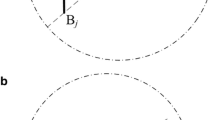Abstract
A new geometric localization approach that is able to locate a stationary tag in non-line-of-sight (NLOS) indoor environment using only the time-of-arrival (TOA) measurements is presented. The novelty of our work resides in converting the NLOS problem into line-of-sight (LOS) problem based on the following three steps, so that the localization algorithm for LOS conditions can be applied in NLOS conditions. First, the geometric TOA model for NLOS is developed, considering the effects of reflection and diffraction. Then, the equivalent anchors can be established based on the geometric features of the real indoor environment. Finally, paths estimation algorithm is derived to estimate the actual signal propagation paths, as well as the position of the tag. Simulation results demonstrate the effectiveness of the proposed method.
Access this chapter
Tax calculation will be finalised at checkout
Purchases are for personal use only
Similar content being viewed by others
References
Z. Li, K. Liu, Y. Zhao et al., MaPIT: an enhanced pending interest table for NDN with mapping bloom filter. IEEE Commun. Lett. 18(11), 1915–1918 (2011)
K. Yu, E. Dutkiewicz, Improved kalman filtering algorithms for mobile tracking in NLOS scenarios. In Proc. IEEE WCNC, Apr. 2012; 2390–2394
K. Yu, Y.J. Guo, Non-line-of-sight detection based on TOA and signal strength, in Proceedings of the 19th IEEE International Symposium PIMRC, Sept 2008, pp. 1–5
S. Al-Jazzar, J. Caffery, You Heung-Ryeol, Scattering-model-based methods for TOA location in NLOS environments. IEEE Trans. Veh. Technol. 56(2), 583–593 (2007)
C.K. Seow, S.Y. Tan, Non-line-of-sight localization in multipath environments. IEEE Trans. Mob. Comput. 7(5), 647–660 (2008)
M.A. Soleimani, A.R. Sharafat, A novel geometric approach for mitigating NLOS effects in wireless location estimation, in Proceedings of the 19th Iranian Conf. Electrical Engineering, May 2011, pp. 1–6
Z. Li, Y. Chen, H. Shi et al., NDFB-GSM-R: a novel high-speed railway communication system via named data networking. EURASIP J. Wirel. Commun. Netw. 48, 1–5 (2016)
X. Liu, Z. Li, P. Yang et al., Information-centric mobile ad hoc networks and content routing: a survey. Ad Hoc Netw. (2016). doi:10.1016/j.adhoc.2016.04.005
Z. Li, L. Song, H. Shi et al., Approaching the capacity of k-user MIMO interference channel with interference counteraction scheme. Ad Hoc Netw. (2016). doi:10.1016/j.adhoc.2016.02.009
B. Alavi, K. Pahlavan, Modeling of the TOA based distance measurement error using UWB indoor radio measurements. IEEE Commun. Lett. 10(4), 275–277 (2006)
N.A. Alsindi, B. Alavi, K. Pahlavan, Measurement and modeling of ultrawideband TOA-based ranging in indoor multipath environments. IEEE Trans. Veh. Technol. 58(3), 1046–1058 (2009)
Y. Kilic, A.J. Ali, A. Meijerink, M.J. Bentum, W. Scanlon, The effect of human-body shadowing on indoor UWB TOA-based ranging systems, in 9th Workshop on Positioning Navigation and Communication (WPNC), Mar 2012, pp. 126–130
Acknowledgements
This work is supported by the National Natural Science Foundation of China under Grant 61601494, 61501493.
Author information
Authors and Affiliations
Corresponding author
Editor information
Editors and Affiliations
Rights and permissions
Copyright information
© 2018 Springer Nature Singapore Pte Ltd.
About this paper
Cite this paper
Liu, D., Yao, Y., Zhai, Y. (2018). TOA Localization in NLOS Environments. In: Liang, Q., Mu, J., Wang, W., Zhang, B. (eds) Communications, Signal Processing, and Systems. CSPS 2016. Lecture Notes in Electrical Engineering, vol 423. Springer, Singapore. https://doi.org/10.1007/978-981-10-3229-5_52
Download citation
DOI: https://doi.org/10.1007/978-981-10-3229-5_52
Published:
Publisher Name: Springer, Singapore
Print ISBN: 978-981-10-3228-8
Online ISBN: 978-981-10-3229-5
eBook Packages: EngineeringEngineering (R0)




